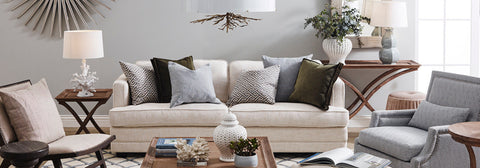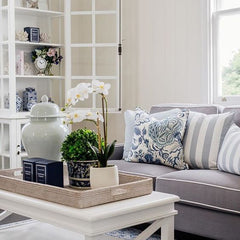28 DAY RETURNS
The Ultimate Cushion Guide: 7 Ways to style your cushions to achieve a designer look

Decorating your home with throw cushions might seem like a simple task, but achieving the perfect balance of comfort, style, and visual appeal can be more challenging than it appears. Cushions are a quick and effective way to inject personality and vibrancy into any room, whether you're styling a sofa, bed, or armchair. However, with so many options in terms of colours, shapes, sizes, and patterns, it’s easy to feel overwhelmed.
To help you navigate the world of cushion styling, House of Isabella’s in-house Interior Designer, Caris Letchford founder of Vibe Design Studio and Interior Designs, offers her expert advice. In this guide, she’ll answer your most pressing questions, from how to choose between symmetrical and asymmetrical arrangements to selecting the right textures and colours.
The Symmetry Debate: Should You Go Symmetrical or Asymmetrical?
One of the first decisions you’ll face when arranging cushions is whether to opt for a symmetrical or asymmetrical layout. Each approach can create a different vibe in your space, so it’s essential to choose the one that best suits your room’s style and purpose.

Symmetry for a Formal Look
Symmetrical cushion arrangements are ideal for creating a polished, formal appearance. This style works particularly well in spaces that exude sophistication, such as formal living rooms or master bedrooms. To achieve this look, place the largest cushions at the ends of the sofa or bed and gradually decrease the size as you move towards the centre. This creates a sense of balance and order, making the space feel cohesive and well-structured.
Asymmetry for a Relaxed Feel
If your space is more relaxed or eclectic, an asymmetrical arrangement might be more appropriate. Asymmetry adds an element of surprise and makes the room feel lived-in and inviting. This approach is perfect for spaces that are used frequently, such as family rooms or casual lounges. For example, a corner sofa with a mix of different-sized cushions can create a cosy, layered effect that invites you to sink in and unwind.
Matching the Room’s Style
It’s also crucial to consider the overall style of your room when deciding between symmetrical and asymmetrical arrangements. An eclectic or bohemian interior may benefit from an asymmetrical layout with cushions in odd numbers and various layers. Conversely, a minimalist or contemporary space might look best with a symmetrical arrangement that highlights clean lines and a curated selection of cushions.
Finding the Right Number of Cushions
One of the most common dilemmas in cushion styling is figuring out how many cushions are just right. While there’s no definitive answer, there are some general guidelines to help you strike the perfect balance.

Personal Preference and Practicality
Your personal preference plays a significant role in determining the number of cushions. However, it’s also essential to consider practicality. Overloading your sofa or bed with cushions can make it difficult to sit or lie down comfortably. Cushions should enhance the space’s style by adding pops of colour and texture, not overwhelm it.
Consider the Scale
The scale of your furniture is another crucial factor. For a large sofa, you may need more cushions to ensure they don’t get lost in the expanse of seating. A queen-sized bed, for example, typically looks best with around five cushions. This provides enough visual interest without making the morning and evening routines cumbersome.
Balancing Form and Function
Remember that cushions are not just for decoration—they should also serve a practical purpose. For a functional yet stylish look, aim to have enough cushions to add comfort and colour without making the space feel cluttered. A good rule of thumb is to use no more than five cushions on a queen bed and adjust accordingly for different furniture sizes.
Mixing Shapes and Sizes for Depth and Interest
Once you’ve decided on the number of cushions, it’s time to think about their shapes and sizes. Mixing different shapes and sizes can add depth and interest to your arrangement, making it more visually appealing.
Start with a Solid Foundation
Begin with the largest cushions as your base. For sofas, this usually means placing the larger cushions at the back to provide support and set the stage for the smaller cushions in front. A standard large cushion size is around 50 cm, which works well as a foundation piece.
Layering for Visual Interest
Layering cushions of different shapes and sizes can create a dynamic look that adds depth to your sofa or bed. Consider adding smaller square cushions, rectangular cushions, or even circular cushions in front of the larger ones. This layering effect creates a sense of progression and makes the arrangement feel intentional and well-designed.
Don’t Be Afraid to Experiment
When it comes to cushion shapes and sizes, don’t be afraid to experiment. Mixing and matching different shapes can lead to interesting combinations that reflect your personal style. For example, pairing a rectangular cushion with a round one can add a playful touch to your arrangement, while maintaining a sense of balance.
Navigating Prints and Patterns
Choosing prints and patterns for your cushions can be daunting, especially if you're unsure how to mix them without clashing. However, with a few strategic choices, you can create a harmonious and stylish look that enhances your room's overall design.

Colour Coordination Is Key
One of the easiest ways to mix prints without creating visual chaos is to stick to a cohesive colour scheme. Start by selecting a primary colour that ties the room together, then choose patterns that incorporate this colour in different ways. For example, if your room has a neutral base, you might opt for cushions with geometric patterns in shades of grey, beige, and white, with a pop of colour to add interest.
The Rule of Three
A popular approach when mixing patterns is the "rule of three." This involves selecting three different patterns that share a common colour palette. For instance, you might choose a large floral print, a smaller geometric print, and a solid-colour cushion in the same tones. This creates a balanced look that is both dynamic and cohesive.
Anchoring with Solids
To prevent your arrangement from becoming too busy, include at least one solid-colour cushion among the patterns. A solid cushion acts as an anchor, providing a visual break and helping to tie the arrangement together. This can be especially useful if you're working with bold or intricate patterns.
Playing with Texture
In addition to prints, don’t forget to play with texture. Mixing different textures can add another layer of interest to your cushion arrangement. For example, a velvet cushion paired with a linen one creates a pleasing contrast that adds depth and sophistication to the space.
Embracing the Power of Layers
Layering isn’t just for shapes and sizes—it's also essential when it comes to textures. Different textures can evoke different feelings, from the warmth of wool to the luxury of velvet.

Textured Fabrics for Depth
There are so many textured fabrics on the market today, including wool, velvet, leather, and vinyl. Each material brings a unique feel to your cushion arrangement. For instance, velvet cushions add a touch of luxury and softness, while leather cushions offer a sleek, modern edge. Wool cushions, on the other hand, bring warmth and cosiness to a space.
Mix and Match for Balance
To avoid a cluttered look, be mindful not to overuse one particular texture. Instead, aim for a balanced mix that complements the rest of the room. For example, you might use predominantly cotton cushions with a pop of velvet and wool. This combination creates a rich, layered look without overwhelming the space.
Throw Rugs as a Stylish Addition
Another way to introduce texture is through throw rugs. A throw rug not only adds a stylish touch but also emphasises luxury and practicality. Draped over the back of a sofa or the foot of a bed, a throw rug can tie the entire arrangement together, making the space feel complete and inviting.
Crafting the Perfect Colour Palette
Colour is a powerful tool in interior design, and your choice of cushion colours can have a significant impact on the overall feel of a room. To create a cohesive look, consider the existing colours in your space and how they can be reflected in your cushion arrangement.
Drawing Inspiration from Surrounding Decor
When selecting cushion colours, take cues from the artwork, rugs, and decorative pieces already present in the room. These elements can guide your colour choices, ensuring that your cushions complement the overall design.
Monochromatic Schemes for Elegance
For a sophisticated and cohesive look, consider sticking to a monochromatic colour scheme. This involves using different shades of the same colour throughout your cushions. For example, if your room features shades of blue, you might opt for cushions in varying tones of navy, sky blue, and teal. This creates a unified look that is easy on the eyes.
Adding a Pop of Colour
If you prefer a bolder approach, consider introducing a pop of colour that stands out from the rest of the room. This can be done through a single cushion or a pair of cushions in a contrasting hue. However, be careful with your choice of colour—make sure it complements the existing palette and doesn't clash with other elements in the room.
Using the Colour Wheel
A helpful tool in selecting harmonious colours is the colour wheel. The colour wheel can help you understand which colours work well together and which combinations might create visual tension. Whether you're choosing complementary colours (opposites on the wheel) or analogous colours (neighbours on the wheel), the colour wheel can guide you in creating a balanced and visually appealing arrangement.
The Final Touch: The Art of the "Chop"
Once you've chosen your cushions and arranged them to perfection, there’s one final touch that can make all the difference—the "chop." This simple styling technique involves lightly chopping the top of each cushion to create an indentation, giving it a plush, lived-in look.
Why the "Chop" Matters
The "chop" isn’t just about aesthetics—it also signals luxury and comfort. Cushions that can hold a master and look soft and inviting are more appealing to use and display. This technique isThis technique is particularly effective with cushions that have a duck feather insert, which ensures they remain plush and soft. When styling your cushions, a quick chop down the middle can make them look effortlessly luxurious.

When to Skip the Chop
While the "chop" works well for square cushions, it isn’t necessary for every shape. Cushions that are rectangular, round, or heavily textured may not benefit from this technique. Instead, these cushions can be left as they are, contributing to the overall texture and shape variety in your arrangement.
Conclusion: Perfecting Your Cushion Styling
Throw cushions are a small yet powerful element in home decor that can transform any room. Whether you’re dressing up a sofa, bed, or armchair, the right combination of cushions can add depth, texture, and colour to your space, making it feel complete and inviting. By following the tips outlined in this guide—from choosing between symmetrical and asymmetrical arrangements to playing with textures and colours—you can master the art of cushion styling and create a space that reflects your personality and enhances your home’s overall design.
Remember, there’s no one-size-fits-all approach to cushion styling. The key is to experiment with different combinations until you find what works best for your space. Whether you prefer a minimalist arrangement with just a few well-chosen cushions or a more eclectic mix of patterns and textures, the possibilities are endless. With a bit of creativity and attention to detail, you can create a cushion arrangement that not only looks great but also makes your home feel warm, welcoming, and uniquely yours.
So, the next time you find yourself wondering how to make your sofa or bed "pop," refer back to these tips and let your cushions do the talking. Happy decorating!








































